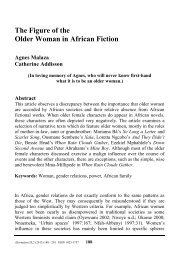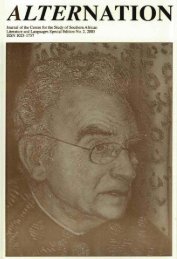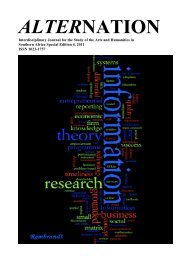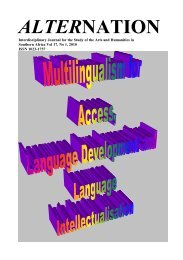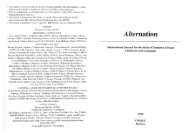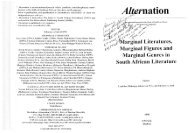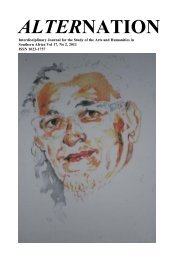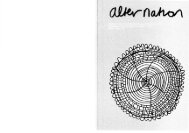Shane Moran - Alternation Journal
Shane Moran - Alternation Journal
Shane Moran - Alternation Journal
Create successful ePaper yourself
Turn your PDF publications into a flip-book with our unique Google optimized e-Paper software.
Current I'rerzds 1n the Prodzrchon of Sorith Afrlcnn H~story<br />
verslon of framing and constructing anew national history from within the TRC is open<br />
to very different versions and subject to a range of interpretations and possibilities.<br />
Desplte these tensions and focuses, however, the TRC has continued to be identified as<br />
a key official site and publicly represented body which will frame and construct a new<br />
national history. The history ofthe TRC and the versions ofhistory presented within the<br />
TRC are multilayered as much they are unfinished. It is therefore appropriate, in this<br />
context, to suggest that the TRC enables two further contradictory processes to become<br />
apparent. On the one hand it already provides a moment, or series of moments from the<br />
public outside, when we can rather<br />
hold up to view the always ambiguous and always inco~nplete relationship<br />
among sites and moments of production of historical knowledge, the sites,<br />
events and experiences represented in that knowledge. and the texts whereby<br />
those productions of knowledge become available to inspection (Cohen<br />
1994:xxii).<br />
But, and this is a significant qualifier, the forms of official and public history-making<br />
being articulated through and around the TRC, and in other arenas of public history<br />
around museums, monuments, heritage and tourism, as exemplified by the Robben<br />
Island Museum, for example, simultaneously appear to be much less about these<br />
ambiguities, hesitancies and range of sites and productions. Here, the face of history<br />
continues to appear as much more narrow, more contained and more directed into the<br />
particular domains of re-fashioning modernity, narrating the new nation, re-writing the<br />
past as reconciliation and re-defining citizenship. What might this version of the past<br />
look like?<br />
Consider the recent opening of the Robben Island Museum on Heritage Day.<br />
The dominant image was one of an address by Mandela against the backdrop of five<br />
faces from left to right: Govan Mbeki, Nelson Mandela, Steve Biko, Robert Sobukwe<br />
and Walter Sisulu. The Cupe Emes caption accompanying the photograph (which was<br />
also the dominant television image) read:<br />
Shaped in Struggle: Let us reco~nmit ourselves to the ideals in our<br />
Constitution-ideals which were shaped in the struggles here on Robben<br />
Island and in the greater prison which was apartheid.<br />
Lmked to the Image were two headlines 'Stop Dep~ct~ng our People a5 Ixsser Belngs'<br />
and 'Mandela slams raclst museums' The otficlal leport, though, desp~te these<br />
headl~ne~, had a more muted message-that 'w~th democracy [Mandela $a~d] we have<br />
the oppo~iulirty<br />
herltage of all clt~zens' "<br />
I<br />
to ensule that our ln\tlnlt~oils<br />
C'czpe Tin~es 25 Scptcliibci (1 997) I'V cover age. 24 Septelnbe~ 1997<br />
124<br />
leflect hlstory rn a way that le.;pects the<br />
M&zn Lrgusszck arrd Gary Mtnkley<br />
During the years of apartheid, MandeEa continued, 'people responded to the<br />
ial and distortion of their heritage with their om afErmation-as indeed Afrikaners<br />
an earlier period'; others worked 'the history of their communit~es into<br />
artefacts'; others celebrated "their heritage outside of the country's museums<br />
meats, in song and in ceremony, En festivals and in carnivals, in the selling of<br />
d in buying items associated with their heritage'. Here, history as heritage<br />
arently cleansed ofthe history ofresistance, In the words of the primary symbol<br />
ance in South Africa! Elsewhere local historians sought to insert 'their history'<br />
w Robben Island Museum. The District Six Museum, representing 'all the<br />
xperienced forced removals' drew out 'the strands of our heritage' by<br />
ex-District Six residents who had been imprisoned or associated with the Island<br />
'ofthe same story' of Robben Island being nationally imaglned on Heritage Day.<br />
here, in the Castle, various symbols and reflections of the colonial past,<br />
could have been mistaken for the meeting of the dioramas of the Natural<br />
Cultural History Museums (from the uniforms of civilized violence to<br />
eroticised nakedness of tribe) took place in a spirit of 'our multicultural and<br />
~iety'~~. These traditional, pre-new South Africa, apartheid South<br />
of the past thus became visibly and publicly part of the way that the<br />
sewn could 'respect the heritage of all our citizens' (as Mandela<br />
Of course, there are multiple strands to these depictions: we wish to emphasise<br />
here. The claiming of the heritage of Robben Island as the 'prison of<br />
id' under the watchful gaze of an elderly male leadership is significant. Its<br />
a1 of national figures of resistance and of symbolic leadership as being a<br />
between men in nationalism traces a particular fictive map of the new<br />
nation. Under the custodianship of this experienced leadership, representing and<br />
standing up for 'the people' in the 'prison of apartheid', a model is provlded to 'shrug<br />
off the chains of the past'" and to embrace the heritage of citizenship on an equal<br />
footing, 'not as lesser human beings'". At the same time the violence of apartheid, as<br />
symbolised most dramatically by Steve ~iko", is presented as part of collective<br />
experience of the five men: they know (and knew) and they symbolise the brutality of<br />
the apartheid past and resistance to it. The fact that Biko was never Imprisoned on the<br />
3%<br />
Cape Times and Cupe Arg~rs 24.25 September (1997); Television coverage 24 September<br />
1997.<br />
-19<br />
A. Odcndaal. Interim Director of the RIM, Cape Times 24 September (1 997).<br />
5%<br />
Nelson Mandela in his Ileritage Day speccli at the opening of the Robben Island Museum.<br />
Cup Times 25 September (I 997).<br />
"<br />
Steve Biko was also syn~bolically important in representing the violence of ;~par!i~cid<br />
through the almost simultii~~eous TRC amnesty hearings detailing his torture and rnurtlcr at tlte<br />
time: as well as when taken togetl~er with his also current public n~clnorialisation in the F,astcrn<br />
Capeassuchasymhol.



